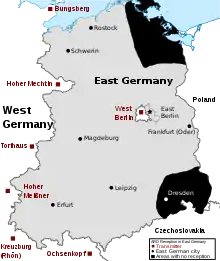Tal der Ahnungslosen
Tal der Ahnungslosen (Valley of the Clueless) was a satirical designation for two regions in the southeast and northeast parts of the former East Germany that generally were not able to receive TV programming from West Germany from the mid-to-late 1950s, including the public broadcasters ARD and ZDF, to early 1990 just prior to German reunification.[1][2]

East Germans used the name ARD with the abbreviation jokingly standing for "Außer (except) Rügen und Dresden" since the programmes could be seen in all other parts of East Germany, such as Erfurt, Leipzig, Magdeburg, and Schwerin. West German television stations were widely considered to be more reliable in their coverage than their Communist East German counterparts, Deutscher Fernsehfunk, and therefore the people who could not receive those stations were thought to be less well informed about the contemporary situation in their country and in the world, despite having access to some Western radio. The West German broadcasters took measures to cover as much of East Germany as possible, building high-powered transmitter sites on the highest ground possible near the border (as well as in West Berlin) and placing ARD on the VHF Band I channels which carried the farthest. Notable in this regard was the transmitter on Ochsenkopf in Bavaria, which covered much of southern East Germany with ARD on VHF channel E4 (61-68 MHz), but required the use of large and conspicuous antennas nicknamed Ochsenkopfantenne for reception.
From the late 1970s onwards as the East German authorities became resigned to the presence of Westfernsehen and with the introduction of cable (and later satellite) technologies the number of East German residents (even in areas far from the border) without access to at least one channel from the West declined further.
External links
- Fernsehempfang im Tal der Ahnungslosen Television reception in Tal der Ahnungslosen
- Im Tal der Ahnungslosen - Westfernsehen Marke Eigenbau Homegrown West TV
- Video (in German)
References
- "TV in the GDR | Screening Socialism | Loughborough University".
- Mitchener, Brandon (1994-11-09). "East Germany Struggles, 5 Years After Wall Fell". The New York Times.
